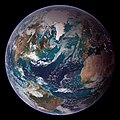Fitxer:Blue Marble Western Hemisphere.jpg

Mida d'aquesta previsualització: 600 × 600 píxels. Altres resolucions: 240 × 240 píxels | 480 × 480 píxels | 768 × 768 píxels | 1.024 × 1.024 píxels | 2.048 × 2.048 píxels | 3.718 × 3.718 píxels.
Fitxer original (3.718 × 3.718 píxels, mida del fitxer: 2,65 Mo, tipus MIME: image/jpeg)
Historial del fitxer
Cliqueu una data/hora per veure el fitxer tal com era aleshores.
| Data/hora | Miniatura | Dimensions | Usuari/a | Comentari | |
|---|---|---|---|---|---|
| actual | 13:59, 5 març 2013 |  | 3.718 × 3.718 (2,65 Mo) | Szczureq | User created page with UploadWizard |
Ús del fitxer
La pàgina següent utilitza aquest fitxer:
Ús global del fitxer
Utilització d'aquest fitxer en altres wikis:
- Utilització a alt.wikipedia.org
- Utilització a av.wikipedia.org
- Utilització a bn.wikipedia.org
- Utilització a ckb.wikipedia.org
- Utilització a cv.wikipedia.org
- Utilització a da.wikipedia.org
- Utilització a el.wikipedia.org
- Utilització a en.wikipedia.org
- Ecological footprint
- User:P3Y229/sandbox
- Wikipedia:Meetup/NYC/AfroCrowd/Home
- Wikipedia:Wikipedia Signpost/2018-10-28/Gallery
- Wikipedia:Wikipedia Signpost/Single/2018-10-28
- User:Lngnbchr/TWA/Earth/2
- User:Saoirse mck/TWA/Earth/2
- User:Northamerica1000/Topics
- User:Nikola Tesla edit/TWA/Earth/2
- User:SDL87/TWA/Earth/2
- User:Mpurcell1/TWA/Earth/2
- User:Mpbrooke/TWA/Earth/2
- User:Tlonedyr
- User:JD Cornbread/TWA/Earth/2
- Utilització a en.wikibooks.org
- Utilització a en.wikiquote.org
- Utilització a en.wiktionary.org
- Utilització a es.wikipedia.org
- Utilització a eu.wikipedia.org
- Utilització a fa.wikipedia.org
- Utilització a fi.wikipedia.org
- Utilització a fr.wikipedia.org
- Utilització a he.wikipedia.org
- Utilització a hu.wikipedia.org
- Utilització a hy.wikipedia.org
- Utilització a id.wikipedia.org
- Utilització a it.wiktionary.org
- Utilització a ja.wikipedia.org
- Utilització a kk.wikipedia.org
- Utilització a ko.wikipedia.org
- Utilització a lez.wikipedia.org
Vegeu més usos globals d'aquest fitxer.




